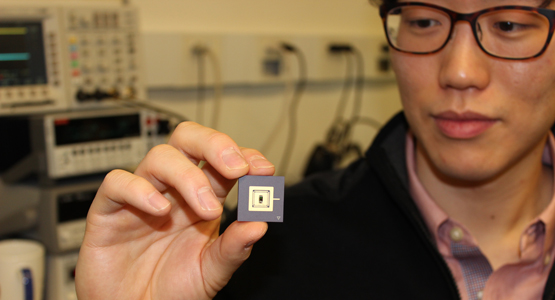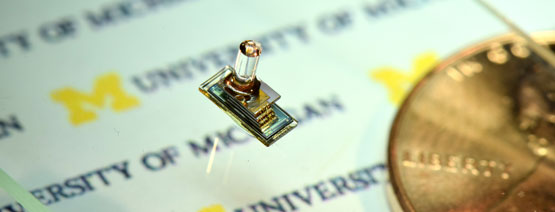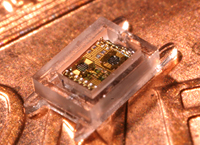


Gyouho Kim
Specialty:
Ultra-low power VLSI design
Advisor: Professors David Blaauw and Dennis Sylvester
Honors: Rackham Predoctoral Fellowship; Best Student Poster Award at the Annual MuSyC Review; DAC/ISSCC Student Design Contest winner; Arjun Chandran Memorial Scholarship; KLA-Tencor Corporate Scholarship
“The most exciting aspect of my research is that I’m working on something that didn’t exist before. It feels great to be part of the drive towards the next generation of miniaturized computing platforms,” said Gyouho Kim, Ph.D. candidate in electrical engineering. He works with Professors David Blaauw and Dennis Sylvester, who are conducting some of the hottest research out there.
Gyouho is close to completing his thesis, “Ultra-Low Power Optical Interfaces for Nearly Invisible Cubic-Millimeter Wireless Sensor Nodes” – research for which he was awarded the Rackham Predoctoral Fellowship. This prestigious fellowship is awarded to support outstanding PhD candidates in the final stages of their program whose research is uniquely creative and ambitious.
Gyouho is designing a millimeter-scale visual system that is complete with optics, processing capability and battery. These miniature sensors are dwarfed by every device currently available, and use solar cells to harvest the minuscule amount of energy they need to operate. The power demands of the device were significantly reduced by incorporation of a motion detector, which alerts the system when to wake up and begin capturing images.
 |
| Gyouho's millimeter-scale wireless imaging system with continuous motion detection and energy harvesting was presented at the 2014 Symposia on VLSI Technology and Circuits. Gyouho was first author among 13 researchers, including his advisors, Professors Blaauw and Sylvester. |
Leading up to this millimeter-scale visual system, Gyouho contributed to several key projects at Michigan, all focused on achieving extreme power efficiency in circuits and devices.
 He was a member of the team that created the first complete millimeter-scale computing system, in the form of a pressure monitor designed to be implanted in the human eye to track the progress of glaucoma. (read more)
He was a member of the team that created the first complete millimeter-scale computing system, in the form of a pressure monitor designed to be implanted in the human eye to track the progress of glaucoma. (read more)
 He was also was a member of the Centip3De design team. Centip3De’s near-threshold 7-layer 3D system combines energy efficiency with increased performance for ultra-high performance general purpose computing. This project was a winner in the 2011 DAC/ISSCC Student Design Contest in 2011. (read more)
He was also was a member of the Centip3De design team. Centip3De’s near-threshold 7-layer 3D system combines energy efficiency with increased performance for ultra-high performance general purpose computing. This project was a winner in the 2011 DAC/ISSCC Student Design Contest in 2011. (read more)
One rather fascinating side project was Gyouho’s collaboration with the Navy on a project dubbed, Chip-on-Mud. The Navy developed a small microbial fuel cell (MFC) that generates very low levels of electrical power from organic reactions of bacteria. To prove that these MFCs generate enough power to run a chip, Gyouho hauled the group’s ultra-low-power M3 chips along with their testing equipment out to San Diego. He successfully demonstrated that MFC's could, in fact, power a chip, but only a chip that's able to run on extremely low power.
Back when he was a prospective college student, Gyouho was debating between a major in business and engineering. He chose Michigan over other top ranked schools because of its international reputation in both business and engineering. An independent self-starter, he traveled to the United States from Korea as a high school student - alone.
Gyouho began working with his advisors as an undergraduate student through the SURE (Summer Undergraduate Research in Engineering) program. In addition to learning how to conduct innovative research over the years, he’s grown to appreciate the importance of teamwork by working with both Blaauw and Sylvester, who frequently collaborate on major research projects.
“Some people don’t realize how important teamwork is in engineering,” said Gyouho. “Developing teamwork skills and social skills is really important to be successful in research.” For example, Gyouho says the article his group recently submitted for publication has fifteen authors – an amazing feat of creative collaboration.
"It's always a collaborative effort in projects like this, but one guy has to lead," he added. Now it's Gyouho's turn.
July 16, 2014